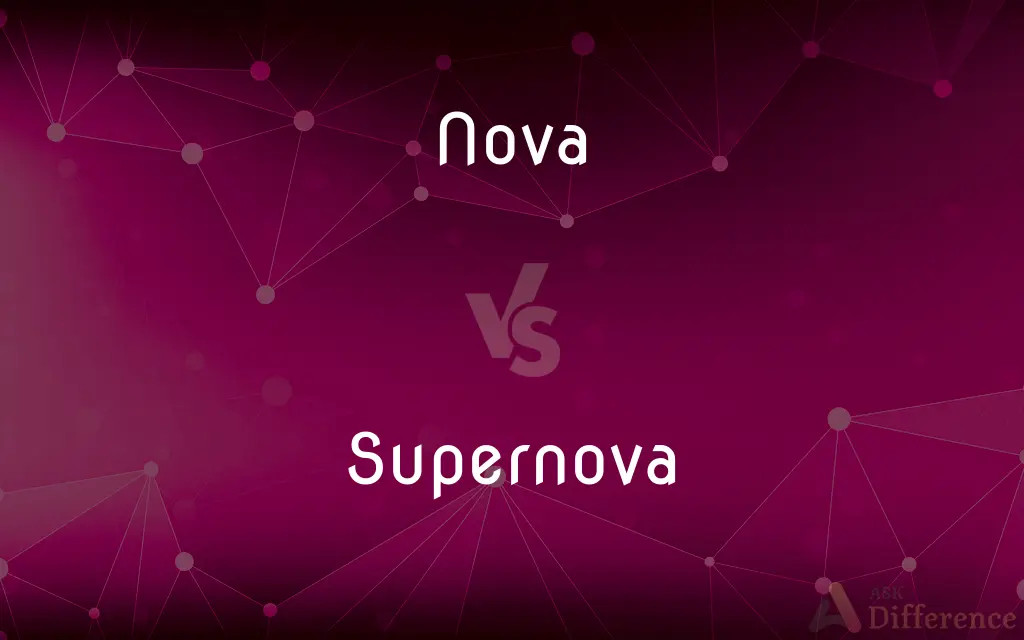Nova vs. Supernova — What's the Difference?
By Fiza Rafique & Maham Liaqat — Updated on March 12, 2024
A nova involves a white dwarf's surface eruption, while a supernova is a massive star's explosive end.

Difference Between Nova and Supernova
Table of Contents
ADVERTISEMENT
Key Differences
A nova occurs in a binary star system where a white dwarf pulls material from its companion star, leading to a thermonuclear explosion on the white dwarf's surface. This results in a sudden brightening of the star. In contrast, a supernova is a catastrophic explosion marking the end of a massive star's life cycle, either due to the collapse of its core or a runaway nuclear fusion reaction, resulting in an incredibly bright and powerful burst of energy.
While novae are less intense and can recur in the same star system as the white dwarf continues to accrete material, supernovae are vastly more powerful and signify the star's final evolutionary stages, often resulting in the creation of a neutron star, black hole, or dispersing the star's material into space.
The brightness of a nova is significant but pales in comparison to a supernova, which can outshine entire galaxies and be visible from great distances across the universe. Supernovae also play a crucial role in distributing heavy elements throughout the cosmos, contributing to the chemical diversity necessary for planets and life.
Novae primarily involve hydrogen fusion on the surface of a white dwarf, whereas supernovae involve more complex nuclear reactions and can result in the fusion of elements up to iron in the case of massive stars or the synthesis of even heavier elements during the explosion.
The frequency of novae and supernovae also differs, with novae occurring more commonly within our galaxy due to their less catastrophic nature. Supernovae are rarer events, but their impact on the cosmos, including galactic evolution and chemical enrichment, is profound.
ADVERTISEMENT
Comparison Chart
Event Type
Thermonuclear explosion on a white dwarf's surface.
Catastrophic explosion marking the end of a massive star.
Intensity
Less intense, can recur in the same system.
Extremely powerful, a star's final explosion.
Visibility
Bright but less so than supernovae.
Can outshine galaxies, visible across vast distances.
Role
Causes a star to brighten suddenly.
Distributes heavy elements, influences galactic evolution.
Outcome
White dwarf remains, may experience more novae.
Often results in a neutron star, black hole, or disperses material.
Compare with Definitions
Nova
Recurring Phenomenon
The same white dwarf can experience multiple nova eruptions.
Supernova
Massive Star's Demise
A supernova marks the explosive end of a massive star's life.
Nova
Binary System Event
A nova occurs when a white dwarf accretes material from its companion.
Supernova
One-time Event
Once a star goes supernova, it's the end of its life cycle.
Nova
Surface Explosion
The explosion in a nova is confined to the white dwarf's surface.
Supernova
Core Collapse or Fusion Reaction
Supernovae can result from core collapse or a runaway fusion reaction.
Nova
Hydrogen Fusion
Novae primarily involve the fusion of hydrogen on the white dwarf's surface.
Supernova
Element Synthesis
Supernovae contribute to the synthesis of heavy elements.
Nova
Galactic Occurrence
Novae are relatively common within our galaxy.
Supernova
Universal Impact
Supernovae play a key role in the evolution of galaxies and chemical enrichment.
Nova
A nova (plural novae or novas) is a transient astronomical event that causes the sudden appearance of a bright, apparently "new" star, that slowly fades over several weeks or many months. Causes of the dramatic appearance of a nova vary, depending on the circumstances of the two progenitor stars.
Supernova
A supernova ( plural: supernovae or supernovas, abbreviations: SN and SNe) is a powerful and luminous stellar explosion. This transient astronomical event occurs during the last evolutionary stages of a massive star or when a white dwarf is triggered into runaway nuclear fusion.
Nova
Salmon that has been lightly cured and smoked. Also called Nova lox.
Supernova
A rare celestial phenomenon involving the explosion of a star and resulting in an extremely bright, short-lived object that emits vast amounts of energy. Depending on the type of supernova, the explosion may completely destroy the star, or the stellar core may survive to become a neutron star.
Nova
A star that suddenly increases in luminosity and then gradually returns to its original brightness over a period of weeks to years.
Supernova
(star) The explosion of a star, which increases its absolute magnitude to typically a billion times that of our sun. Some leave only debris, while others fade to invisibility as neutron stars or black holes.
Nova
(astronomy) Any sudden brightening of a previously inconspicuous star.
Supernova
(figurative) Something brilliant.
Nova
A star which suddenly increases in brightness thousands of times, then fades back to near its original intensity. It may appear as a "new" star if its original brightness was too low for routine observation. A star which suddenly increases in brightness to many millions of times its original intensity is a supernova, and the postulated mechanisms for the increases of brightness of novae and supernovae are different.
Supernova
A star that explodes and becomes extremely luminous in the process
Nova
A star that ejects some of its material in the form of a cloud and become more luminous in the process
Common Curiosities
Can a star experience both a nova and a supernova?
Typically, a star that undergoes a nova will not later become a supernova, as these phenomena occur in different types of stars and scenarios.
How often do supernovae occur?
In a galaxy like the Milky Way, supernovae occur about once every 50 to 100 years.
Can a nova or supernova destroy Earth?
A supernova would need to be within a few dozen light-years to significantly harm Earth, which is highly unlikely. Novae pose no threat to Earth.
Do novae and supernovae happen in all galaxies?
Yes, these phenomena can occur in all galaxies that contain stars at the relevant stages of their life cycles.
What is left after a supernova?
The remnants of a supernova can be a neutron star, a black hole, or an expanding nebula of gas and dust.
Can humans see novae and supernovae with the naked eye?
Supernovae can sometimes be seen with the naked eye if they are relatively close. Novae are generally too faint to be seen without a telescope.
Are there different types of supernovae?
Yes, supernovae are classified into types based on their spectra and light curves, with Type Ia, Ib, Ic, and Type II being the main categories.
How long does a nova or supernova last?
The visible brightness of a nova can last from days to months, while a supernova's brightness can last for several weeks to months before fading.
How are novae and supernovae detected?
They are detected through telescopes by observing their sudden increase in brightness.
Can a nova become as bright as a supernova?
No, novae are significantly less bright than supernovae, which can outshine entire galaxies.
Are novae and supernovae important for Earth?
Supernovae are essential for distributing elements necessary for life, whereas novae have less direct impact on Earth.
What research is being conducted on novae and supernovae?
Research focuses on understanding their mechanisms, frequencies, and effects on cosmic evolution and element formation.
What is a Type Ia supernova?
A Type Ia supernova occurs in a binary system where a white dwarf accretes enough mass to reach a critical threshold and undergoes a thermonuclear explosion, different from a nova.
What triggers a nova?
A nova is triggered by the accumulation of hydrogen on the surface of a white dwarf from its companion star, eventually leading to a thermonuclear explosion.
How do novae and supernovae contribute to science?
They help astronomers understand stellar evolution, galaxy formation, and the cosmic distribution of elements.
Share Your Discovery

Previous Comparison
Pulsar vs. Quasar
Next Comparison
Handyperson vs. HandymanAuthor Spotlight
Written by
Fiza RafiqueFiza Rafique is a skilled content writer at AskDifference.com, where she meticulously refines and enhances written pieces. Drawing from her vast editorial expertise, Fiza ensures clarity, accuracy, and precision in every article. Passionate about language, she continually seeks to elevate the quality of content for readers worldwide.
Co-written by
Maham Liaqat














































